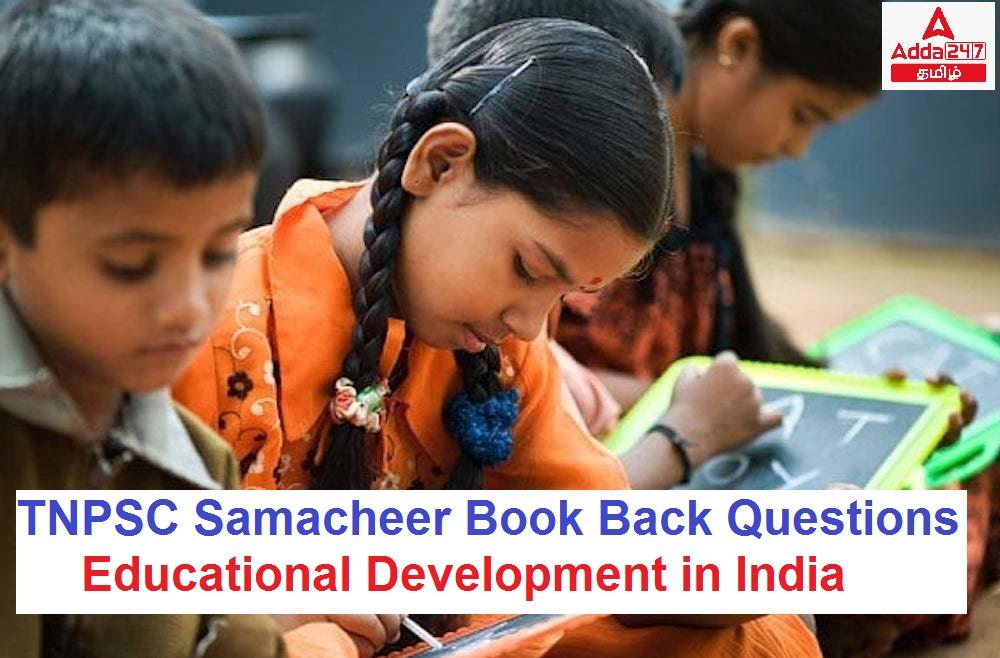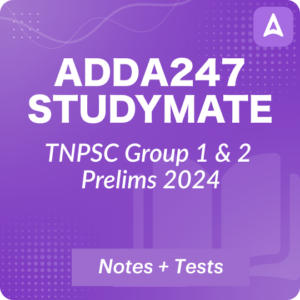TNPSC Samacheer Book Back Questions: ADDA 247 Tamil is giving you TNPSC Samacheer Book Back Questions Educational Development in India MCQs for all competitive exams. Here you get Multiple Book Back Choice Questions and Answers. Here you will find all the important questions and answers that will help you increase your knowledge and move you toward fulfilling your goals. Study these TNPSC Book Back Questions MCQs and succeed in the exams.
Attend TNPSC Book Back Question Quiz Here
Choose the correct answer:
Q1. The word ‘Veda’ is derived from _________.
(a) Sanskrit
(b) Latin
(c) Prakrit
(d) Pali
S1.Ans.(a)
Sol.
- The concept of Education might have originated from the Vedas.
- The Sanskrit word ‘Veda’ is knowledge and the word derived from the word Vid, which means ‘to know’.
Q2. Which of the following was an important centre for learning in the ancient period?
(a) Gurukula
(b) Viharas
(c) Palli
(d) All of these
S2.Ans.(d)
Sol.
- During the early period education was imparted by the teacher (Guru/Acharya) to the pupils who gathered around him and came to live in his house as members of his family.
- This was known as Gurukula system of eduation.
- Students went to viharas and universities for higher studies.
- In ancient times, the school was called ‘Palli’ and the teacher was a ‘Kanakkayar’.
Q3. Nalanda, the oldest university in India was located in
(a) Uttar Pradesh
(b) Maharashtra
(c) Bihar
(d) Punjab
S3.Ans.(c)
Sol.
- The ancient Nalanda University was a centre of learning from the 5th century AD (CE) to 12th century AD (CE).
- Located in present-day Rajgir, Bihar.
- Nalanda was one of the oldest universities of the world and UNESCO declared the ruins of Nalanda Mahavihara a world heritage site.
- The new Nalanda University is envisaged as a centre of inter-civilisational dialogue.
Q4. When did UNESCO declare Takshashila as a world heritage site?
(a)1970
(b) 1975
(c) 1980
(d) 1985
S4.Ans.(c)
Sol.
- Taxila was an ancient Indian city, which is now in northwestern Pakistan.
- It is an important archaeological site and UNESCO declared it as a world heritage site in 1980.
- Its fame rested on the university where Chanakya is said to have composed his Arthashastra.
- Archaeologist Alexander Cunningham discovered its ruins in the mid-19th century.
Q5. Which European country were the first to start the Modern System of Education in India?
(a) British
(b) Danish
(c) French
(d) Portuguese
S5.Ans.(d)
Sol.
- The Portuguese were the first Europeans who started the modern system of education in India.
- Francis Xavier, a Jesuit, started a university at Cochin.
Q6. Which of the following Charter Act made a provision for an annual grant of one lakh Rupees for the promotion of Education in India?
(a) Charter Act of 1813
(b) Charter Act of 1833
(c) Charter Act of 1853
(d) Charter Act of 1858
S6.Ans.(a)
Sol.
- In 1813, the East India Company was compelled to assert the responsibility for the education of the Indians.
- Charter of Act of 1813 made a provision for an annual grant of a sum of 1 lakh rupees for the promotion of education in India.
Q7. Which of the following Commission recommended to constitute the University Grants Commission?
(a) Sergeant Report, 1944
(b) Radhakrishnan Commission, 1948
(c) Kothari Commission, 1964
(d) National Education Policy, 1968
S7.Ans.(b)
Sol.
- In 1948, Dr. Radhakrishnan Commission was appointed to present a report on University education.
- In pursuance of the Commission’s recommendations, University Grants Commission was constituted to determine the standard of higher education.
Q8. In which year the New Education Policy was introduced in India?
(a)1992
(b) 2009
(c) 1986
(d) 1968
S8.Ans.(c)
Sol.
- In 1986, the Government of India introduced a New Education Policy.
II Fill in the blanks:
- The word ‘Veda’ means _________. (to know)
- Taxila ruins were discovered by _________. (Alexander Cunningham)
- _________ was the first ruler to establish a madrasa at Delhi. (Iltutmish)
- The New Education Policy was revised in _________. (1992)
- _________ is the primary vehicle for implementing the provisions of the Right to Education Act of (RTE) 2009. (Sarva Shiksha Abhiyan (SSA))
- The Mid-day meal program was introduced in schools in _________. (1956)
III
Q9.Match the following
- I – Tsing – 1.Saraswathi mahal
- Francis Xavier – 2.Magnacarta of Indian Education
- Wood’s Despatch – 3.Western Education in Madras
- Sarafoji II – 4.University at Kochin
- Sir Thomas Munro – 5.Chinese scholar
(a) 5 4 2 1 3
(b) 5 4 2 1 3
(c) 3 4 5 1 2
(d) 4 1 3 2 5
S9.Ans.(b)
Sol.
5 4 2 1 3
IV State True or False:
- The writings of Charaka and Sushrutha were the sources of learning of medicine. True
- Temples were the centers of learning and played an active role in the promotion of knowledge. True
- The Jataka tales tell us that the kings and society took an active interest in promoting education. True
- Women education in India was not prevalent during the medieval period.False
- The RMSA scheme was implemented during the tenth Five Year Plan.False
V Consider the following statements and tick (✓) the appropriate answer
Q10.
- i) The Nalanda University was founded in fifth century C.E
- ii) In ancient India teachers had complete autonomy in all aspects from selection of students to designing their syllabi
iii) In ancient times the teacher was called Kanakkayar.
- iv) The famous college during the Chola period was Kandhalur salai.
(a) i and ii are correct
(b) ii and iv are correct
(c) iii and iv are correct
(d) i, ii and iii are correct
S10.Ans.(d)
Sol.
- In ancient times, the school was called ‘Palli’ and the teacher was a ‘Kanakkayar’.
- The famous college during the Pandya regime was Kandhalur Salai
Q11. Find out the Correct Pair
(a) Maktabs – Secondary School
(b) Macaulay’s Minutes of 1835 – English education
(c) Operation Blackboard –Secondary Education Commission
(d) Salabhogam – Lands were given to temples
S11.Ans.(b)
Sol.
- Maktabs – Primary School
- Macaulay’s Minutes of 1835.
- Higher education was de-orientalised, encouraging English education for the upper classes.
- Operation Blackboard to improve primary schools nationwide.
- Lands were given to teachers. They were known as Salabhogam (e.g. Vallabha Perunchalai at Kanyakumari).
**************************************************************************
| Adda247 TamilNadu Home page | Click here |
| Official Website=Adda247 | Click here |




